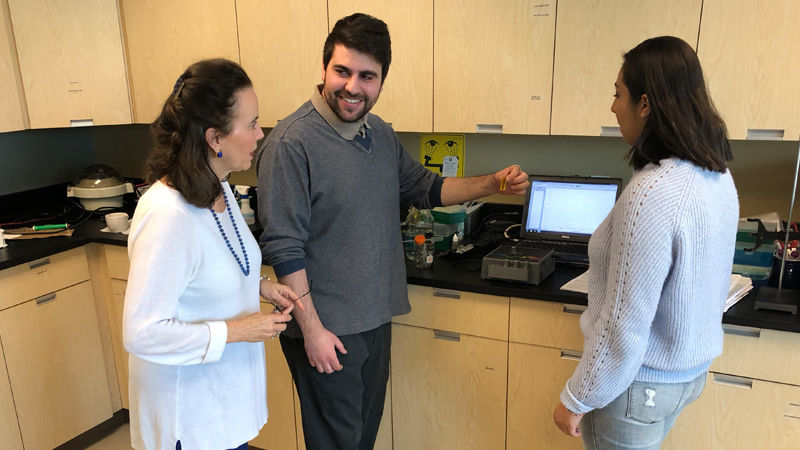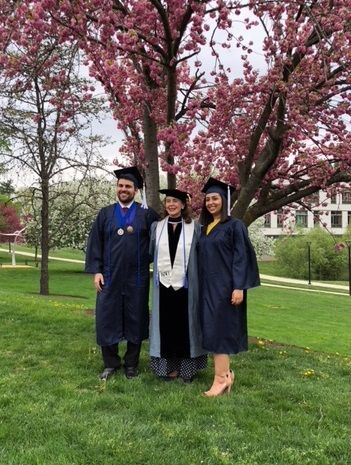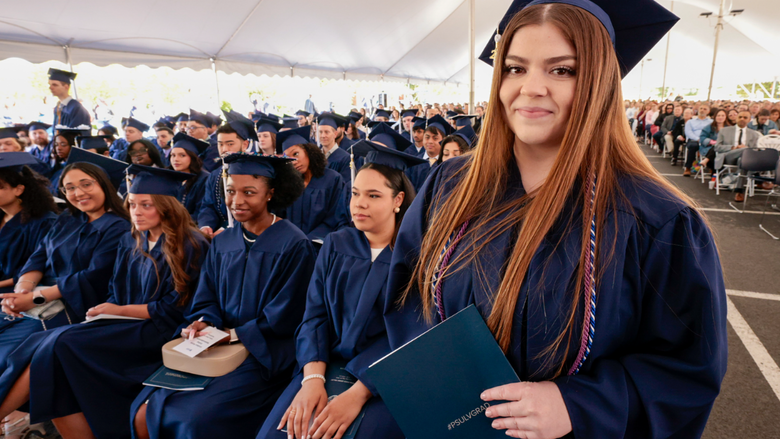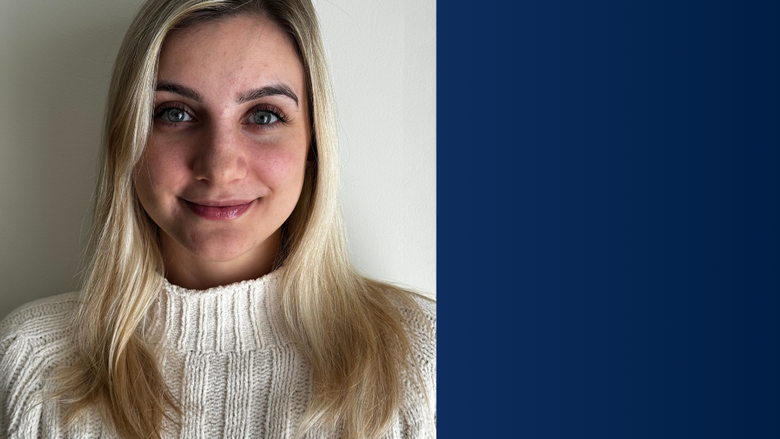

This dialog contains the full navigation menu for this site.

For more than 10 years, Julie Ealy, associate professor of chemistry at Penn State Lehigh Valley (PSU-LV), has worked on in-depth chemistry research with undergraduate students, providing a valuable opportunity that most college students do not get to experience.
She spent the past two years working closely with Habib Yazgi, a Schreyer Scholar, and Noorhaan Abouomar, both former PSU-LV students, who continued working with Ealy even after they both transferred to Penn State Berks. Forthcoming from that research will be at least two articles on the binding of four different molecules to riboflavin binding protein. Previous to this research Habib and Noorhaan contributed to research with six other PSU-LV students who worked with Ealy for five years total. Those students included Justin Cohen, Paolo Flauta, Liliana Nassar, Matthew Mekolochik, Sarah Ramzy and Christopher Shannon. An article, “Estimated Binding Energies of Drug-like and Nondrug-like Molecules in the Active Site of HIV-1 integrase, 1BIS.pdb, and Two Mutant Models: Y143R and N155H” was published from the research appearing in the Advances in Bioscience and Biotechnology Journal.
“Dr. Ealy has provided her students a tremendous and unique opportunity to gain high-quality hands-on research as undergraduate students that has spanned semesters, sometimes years and even campus locations,” said Douglas Hochstetler, interim director of academic affairs at PSU-LV. “As a prominent research institution, Penn State emphasizes the value of research and we are proud to offer students the chance to work with esteemed faculty on research at PSU-LV. I commend Dr. Ealy for prioritizing student research and also, giving her students ample opportunities to present their research and findings.”
Ealy earned a doctorate of philosophy in chemical education from Columbia University. While at Penn State Lehigh Valley she has spent half of her research on chemistry education, and the other half on scientific research, mostly biology and biochemistry. Ealy earned a master of science in secondary education with a minor in health from Northern Illinois University, and a bachelor of arts in biology from SUNY Buffalo. Ealy has taught at PSU-LV since September 2001.
While on sabbatical in the spring and summer of 2010, Ealy worked with Dr. Michael Katzman, an infectious disease specialist at Penn State Hershey Medical Center. She learned valuable new techniques while she researched HIV-1 integrase, one of the three enzymes involved with HIV reproduction. She went on to apply and share the skills she learned at Hershey with her PSU-LV students.
“I also learned something new during that experience – that I need to ask for help,” Ealy said.
This lesson possibly enhanced Ealy’s ability to work so closely with her student researchers.
“I never pick research students because of their grades. I am comfortable saying, ‘I don’t know’ or ‘I don’t understand.’ I want to know that they are kind, not judgmental. I want them to be able to question things and be able to ask them ‘what do you think?’” Ealy said. “It is a give and take relationship and is a very distinct learning experience. We work together as equals and that requires a level of respect.”
Habib and Noorhaan had Ealy for chemistry lecture and lab during their first year at PSU-LV when they expressed interest in possibly working with her. Both students were mentored by Ealy during the second semester of their freshman year so they would be ready as sophomores to begin research.
The first research topic that Ealy, Habib and Noorhaan worked on together was finishing up the estimated binding energy research Ealy had started along with other PSU-LV students. Their research looked at the estimated binding energies of drug-like and nondrug-like molecules in the active site of HIV-1 integrase. HIV-1 integrase was the last protein associated with HIV to have a drug developed for it.
They presented their poster, titled “Estimated Binding Energies of Drug-like and Nondrug-like Molecules in the Active Site of HIV-1 Integrase, 1BIS.pdb, and Mutated 1BIS.pdb” at the American Chemical Society Meeting in Philadelphia in August 2016.
After this, their research moved to the next phase where they explored the binding affinity of flavins with riboflavin binding protein (RBP). RBP is important in fetal development. They researched the binding affinities obtained from fluorescence spectroscopy, from isothermal titration calorimetry, and estimated binding energies from computational chemistry.
Between Yazgi’s sophomore and junior year, he attended a one-week bioinorganic workshop at University Park with Ealy.
“This is where we were introduced to isothermal titration calorimetry (ITC) and made connections with the Huck Institutes of the Life Sciences which provided grant money that allowed for the use of instruments at University Park. We realize we needed this experimental technique for our research,” Yazgi said.
Upon returning home, wet bench research began using fluorescence spectrometry.
“When developing a drug, you want to be able to inhibit the protein. When a drug docks with a protein, you want the binding energy value to be negative because that indicates tighter binding with the protein, and hopefully the drug will inhibit the protein. A computer program can estimate the binding energies,” Ealy said. “We used four molecules and wanted to see how accurate computational software was in assessing estimated binding energies. Ideally it would be best if computer software, which is cost-effective, could operate like wet bench research, which can become expensive because of the cost of chemicals. The goal would be to have computer programs designed to emulate the wet bench research.”
They presented their poster titled, “Spectrophotometric Fluorescence and Isothermal Titration Calorimetry Used to Determine the Binding Affinity of Flavins with Riboflavin Binding Protein and Computationally Calculated Estimated Binding Energy” at the Middle Atlantic Regional Meeting of the American Chemical Society in Hershey, Pa. in July 2017.
“When we presented to the American Chemical Society, we were presenting our research to graduate students!” Abouomar said.
“We started with research on HIV-1 integrase computationally, then by the next year we were presenting a poster at a national meeting. And all of this was done outside of class time,” Yazgi said.
Yazgi and Abouomar said they were able to apply what they were studying in real-time to their research with Ealy, and also they learned the invaluable lesson of teamwork.
“The research offered a good chance to apply and absorb what I learned and not be passively receiving the information. I was motivated by Dr. Ealy to take my learning and apply it to this research. I already see how this will benefit me when I am a doctor someday when I plan to take the science and apply it uniquely to my patients,” Yazgi said.
Abouomar said one of her friends at University Park was waiting in line for a chance to do undergraduate research but did not have the opportunity because of the size of the campus and the fact that many professors have graduate or doctoral students working on their research with them already.
“This is so meaningful to work with Dr. Ealy. The opportunity to do undergraduate research at this level is an incredible thing. That is why every Friday morning I drove an hour from Berks just to work with her at PSU-LV. For example, I learned how to purify a protein, which is an important technique many undergrad students do not get to learn, and that is just one of the things I learned,” Abouomar said.
“When you are in class with someone, it is just for one semester, but this research has been years of working together. I see the value in working with others; when thinking and working as a team, it helps make the process quicker,” Yazgi said.
Yazgi graduated from Penn State Berks in 2018 as a Schreyer Scholar with a biology degree. Ealy served as Yazgi’s Schreyer Scholar Thesis supervisor. His thesis was a spin-off of their research together. It was actually the first time that scientific Schreyer Scholar research was completed at Penn State Lehigh Valley.

Ealy (center) attended and walked at the Penn State Berks commencement ceremony in May 2018 to celebrate with Yazgi and Abouomar. Ealy served as Yazgi’s Schreyer Scholar Thesis supervisor.
Yazgi applied and was accepted to Hershey Medical School. He started in July 2018.
“The Lehigh Valley campus is small, but that means the faculty are more available. Dr. Ealy was so helpful and cooperative and you can tell she is truly committed to her students and to research,” Yazgi said.
Abouomar graduated from Penn State Berks in 2018 with a biochemistry degree. She is currently in graduate school at Drexel University where she will earn a master of science degree in biomedical studies. She said she hopes to do something with pathology in her future work.
“While Noorhan and Habib came at the end of my research on HIV-1 integrase and completed research on riboflavin binding protein, what the three of us have accomplished is amazing for a small campus,” Ealy said. “I thought this research journey would be pretty straightforward. I never expected how challenging it would be; how much help we would need. But that is what research is. I didn’t expect there would be so much learning and mentoring, too, and that all came out of it.”


